Afro-Latino identity is a distinct one, with deep roots in colonial Latin America. As a result, it can often exist alongside a person’s Hispanic, racial or national origin identities. The life experiences of Afro-Latinos are shaped by race, skin tone and other factors, in ways that differ from other Hispanics. And though most Afro-Latinos identify as Hispanic or Latino, not all do so, according to new Pew Research Center estimates based on a survey of U.S. adults conducted from November 2019 to June 2020.
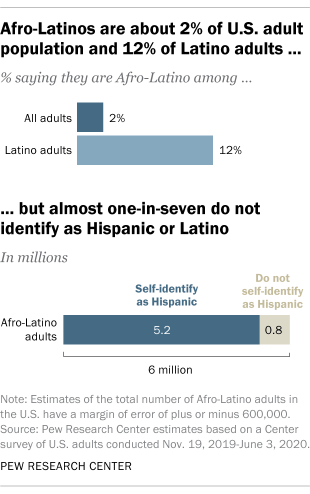
In 2020, there were about 6 million Afro-Latino adults in the United States, and they made up about 2% of the U.S. adult population and 12% of the adult Latino population. About one-in-seven Afro-Latinos – or an estimated 800,000 adults – do not identify as Hispanic.
The multiple dimensions of Latino identity reflect the long colonial history of Latin America, during which mixing occurred among indigenous Americans, White Europeans, Asians and enslaved people from Africa. In Latin America’s colonial period, about 15 times as many African slaves were taken to Spanish and Portuguese colonies than to the U.S. About 130 million people of African descent live in Latin America, and they make up roughly a quarter of the region’s total population, according to recent estimates from the Project on Ethnicity and Race in Latin America (PERLA) at Princeton University.
Pew Research Center conducted this study to understand how Afro-Latino adults in the U.S. compare in their experiences and views of their identity with the overall Latino community.
The estimates of the Afro-Latino adult population are based on a survey of 68,398 adults across the U.S., which was used as a screener for two Pew Research Center studies – a 2020 survey of Jewish Americans and a 2020 survey of Black Americans. Both surveys were conducted from Nov. 19, 2019, to June 3, 2020. Here are further details on the screener survey. The survey estimates were compared with the 2020 decennial census results released by the U.S. Census Bureau to determine the overall number of Afro-Latino adults in the U.S.
Experiences of discrimination and attitudes about race relations among Afro-Latinos were measured in a Pew Research Center survey of 3,375 Hispanic adults in March 2021. The survey explored four different ways to measure racial identity, including an assessment of skin color, and asked people if they identified as Afro-Latino.
The March 2021 survey includes 1,900 Hispanic adults on the Center’s American Trends Panel (ATP) and 1,475 Hispanic adults on Ipsos’ KnowledgePanel. Respondents on both panels are recruited through national, random sampling of residential addresses. Recruiting panelists by phone or mail ensures that nearly all U.S. adults have a chance of selection. This gives us confidence that any sample can represent the whole population (see our Methods 101 explainer on random sampling), or in this case the whole U.S. Hispanic population.
To further ensure the survey reflects a balanced cross-section of the nation’s Hispanic adults, the data is weighted to match the U.S. Hispanic adult population by age, gender, education, nativity, Hispanic origin group and other categories. Read more about the ATP’s methodology. Here are the questions used for our survey of Hispanic adults, along with responses, and its methodology.
Differences in estimates of the Afro-Latino population across surveys
Pew Research Center has included questions in previous surveys that attempt to measure the share of respondents who identify as Afro-Latino. The results vary widely across these surveys. The most recent estimate, which found Afro-Latinos accounted for 12% of Hispanic adults, comes from an online survey of U.S. Hispanic adults conducted in 2021. This same share was found in an online survey of all U.S. adults conducted over more than six months in 2019 and 2020 (which is the survey used in this analysis). Meanwhile, a 2014 survey of Hispanic adults conducted by phone found Afro-Latinos accounted for 24% of U.S. Hispanic adults. The differing estimates could be due to changes in question wording across surveys, different survey modes (online vs. phone) or changes in the actual share of Hispanics who identify as Afro-Latino. The 2014 survey, which produced the largest share of Hispanic adults identifying as Afro-Latino, came from a telephone survey that asked Latino adults if they considered themselves to be Afro-Latino and listed many Afro-Latino subgroups such as Afro-Caribbean and Afro-Peruvian. By contrast, other surveys that yielded lower estimates of the Afro-Latino population were carried out on an online panel and used a shorter version of the question wording that did not include Afro-Latino subgroups.
Estimating the size of the nation’s Afro-Latino population requires a different approach to capturing identity on surveys than is available from U.S. Census Bureau sources. To do this, Pew Research Center asked adults to self-identify as Afro-Latino independently from other questions on race or ethnicity. Asking directly about Afro-Latino identity yields a higher share of respondents who identify as Afro-Latino than by counting as Afro-Latino anyone who identifies as Hispanic and Black in a two-step race question format like the one used by the Census Bureau in the decennial census and its other surveys. Results from the 2020 census, for example, show 1.2 million people of all ages identified as both Hispanic and Black, substantially below the 6 million Afro-Latino adults estimated using the Center’s method.
A demographic portrait of Afro-Latino adults
Afro-Latino adults are considerably younger and less likely to have attended college than the overall U.S. adult population. In 2020, three-in-ten Afro-Latino adults were ages 18 to 29, compared with two-in-ten of all U.S. adults. Among all U.S. adults, about three-in-ten have graduated college, a share about twice as high as among Afro-Latino adults.
Afro-Latino adults have different origins than Latino adults overall. Afro-Latinos are also more likely to be of Puerto Rican or Dominican origin and less likely to be Mexican than Latino adults overall.
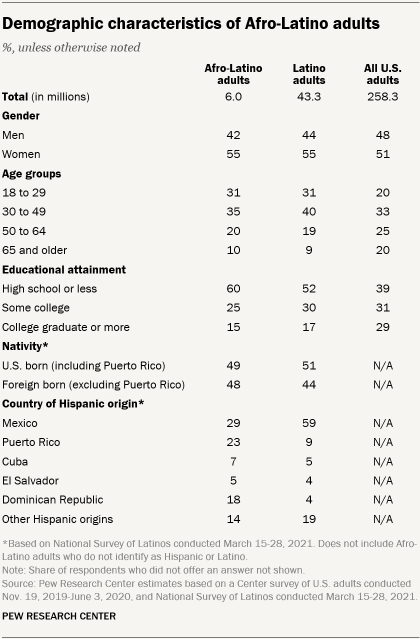
The racial identity of Afro-Latinos
The racial groups Afro-Latinos identify with can be varied and diverse. When asked about their race on a Census Bureau-style question, about three-in-ten Afro-Latinos selected White as their race, 25% chose Black and 23% selected “some other race,” according to the Center survey. An additional 16% selected multiple races, while just 1% said they were Asian. Afro-Latinos who did not identify as Latino were more likely than those who did identify this way to mark Black as their race (59% vs. 17%).
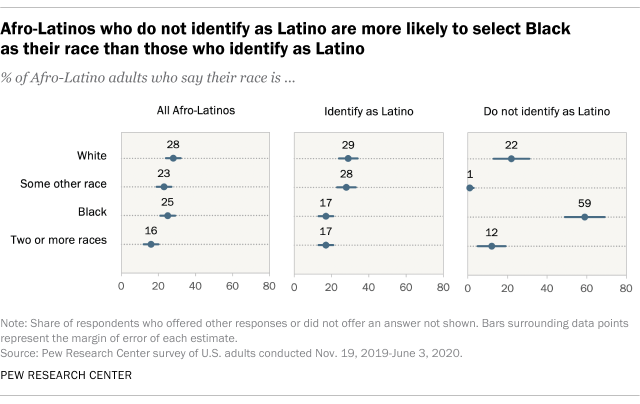
When asked how people would describe them when walking past them on the street, Afro-Latinos who identified as Hispanic or Latino were more likely than other Latinos to say they would be seen as multiracial or mixed race (12% vs. 4%) or Black (7% vs. 1%), according to a different Pew Research Center survey of Latino adults conducted in March 2021. By contrast, Afro-Latinos were less likely than other Latinos to say they would be seen as White (7% vs. 19%)
The same March 2021 survey of Hispanics found that Afro-Latinos who identify as Hispanic or Latino are more likely to say their skin color is darker than other Hispanic adults. The survey asked Hispanic adults to identify the skin color that best resembled their own based on a version of the Yadon-Ostfeld skin-color scale in which respondents were shown 10 skin colors that ranged from light to dark. Among Afro-Latinos, 37% selected a color between five and 10 on the scale, which are darker skin colors. This compares with just 15% of Hispanics overall and 12% of those who do not identify as Afro Latino. Conversely, Afro-Latinos (60%) were less likely than other Hispanics who do not identify as Afro-Latino (83%) to select lighter skin colors – between one and four on the scale.
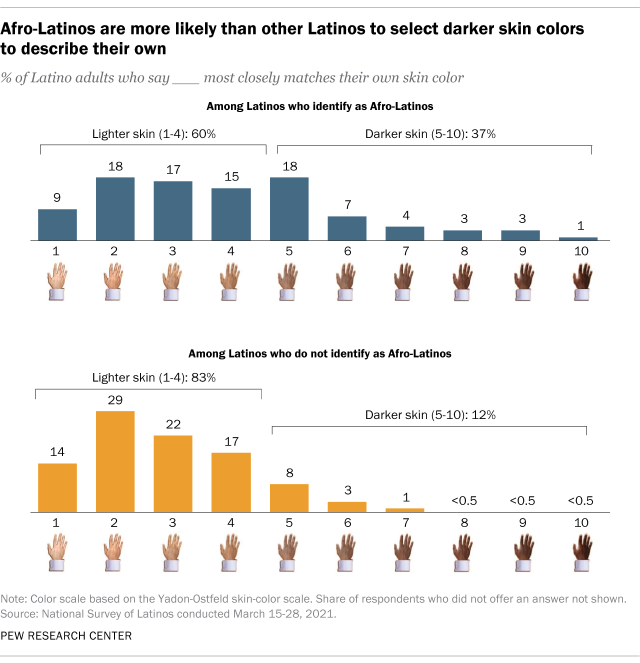
Afro-Latinos report similar experiences with discrimination as other Latinos
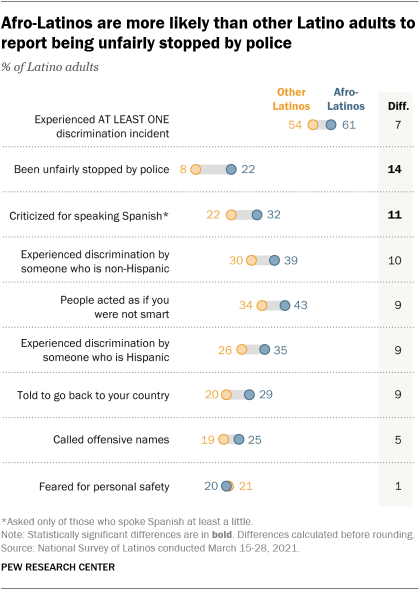
For the most part, similar shares of Afro-Latinos who identify as Hispanic or Latino and other Latinos say they have experienced at least one discrimination incident. About six-in-ten Afro-Latinos (61%) say they personally experienced at least one of eight discrimination incidents asked about on the March 2021 survey of Latino adults, while 54% of Latinos who do not identify as Afro-Latino say the same. Overall, about half (54%) of U.S. Latino adults say they experienced at least one discrimination incident in the year prior to the survey. The shares of three discrimination experiences – being criticized for speaking Spanish, being told to go back to your country, and being called offensive names – are about the same as in 2019, the year before the coronavirus outbreak in the U.S.
Afro-Latinos are more likely to report experiencing two of the eight discrimination experiences included in the survey. More Afro-Latinos than other Latinos say they have been unfairly stopped by police during the year prior to the survey (22% vs. 8%). Similarly, about three-in-ten Afro-Latinos say they have been criticized for speaking Spanish in public, compared with about two-in-ten Latinos who do not identify as Afro-Latino. These are the only two discrimination experiences where the differences between Afro-Latinos and other Latinos are statistically significant.
The most reported instance of discrimination among both groups is people acting as if they thought they were not smart – 43% of Afro-Latinos say this, as do 34% of other Latinos.
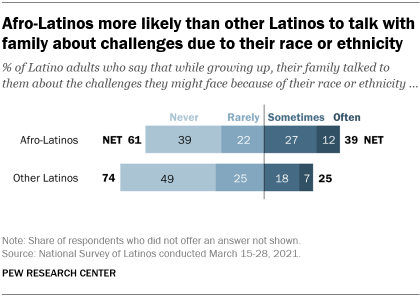
Apart from discrimination, Afro-Latinos are also more likely than other Latinos to have had conversations with family during their upbringing about the potential challenges they might face due to their race or ethnicity. About four-in-ten Afro-Latinos say their family talked to them about this when they were growing up often (12%) or sometimes (27%). Meanwhile, about a quarter of Latinos who do not identify as Afro-Latino say they talked about this topic with their families often (7%) or sometimes (18%).
Note: Here are the questions used for our survey of Hispanic adults, along with responses, and its methodology.
